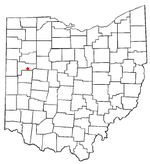Geyer, Ohio
1893 establishments in OhioFormer municipalities in OhioNorthwest Ohio geography stubsPopulated places established in 1893Unincorporated communities in Auglaize County, Ohio ... and 2 more
Unincorporated communities in OhioUse mdy dates from July 2023

Geyer is an unincorporated community in southwestern Clay Township, Auglaize County, Ohio, United States. Geyer is located southeast of Wapakoneta and north of Jackson Center. The community is served by the Wapakoneta City School District and the Wapakoneta (45895) post office. Geyer was laid out in 1893 by George Geyer, and named for him. The village was incorporated in 1900, but surrendered its incorporated status in 1918. A post office was established at Geyer in 1894, and remained in operation until 1911.
Excerpt from the Wikipedia article Geyer, Ohio (License: CC BY-SA 3.0, Authors, Images).Geyer, Ohio
High Street,
Geographical coordinates (GPS) Address Nearby Places Show on map
Geographical coordinates (GPS)
| Latitude | Longitude |
|---|---|
| N 40.509444444444 ° | E -84.063888888889 ° |
Address
High Street
High Street
45884
Ohio, United States
Open on Google Maps










